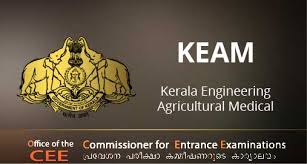KERALA ENGINEERING ENTRANCE (KEAM)
KERALA ENGINEERING ENTRANCE (KEAM)

KEAM, Kerala Engineering Architecture Medical entrance examination is a state level entrance examination conducted by CEE Kerala for admissions to various professional degree courses in the state of Kerala, India. It is conducted by the Office of the Commissioner of Entrance Exams run by the Government of Kerala. Admissions to Engineering courses in various government, Private and self-financing Engineering colleges in Kerala is based on the rank list of this examination.
Engineering Courses:
Bachelor of Technology [(B. Tech.)Includes all Courses listed in Annexure II
B.Tech. (Agricultural Engineering)
B.Tech. (Agri. Engg.) B.Tech. (Food Engineering & Technology) B.Tech. (Food Engg. & Tech) B.Tech. (Dairy Technology) B.Tech. (Food Technology) B.Tech. (Food Tech)
Architecture Course:
Bachelor of Architecture (B.Arch.)
Eligibility
Candidates who have passed Higher Secondary Examination, Kerala, or Examinations recognized as equivalent thereto, with 50% marks in Mathematics separately, and 50 % marks in Mathematics, Physics and Chemistry put together are eligible for admission. However candidates who have passed Higher Secondary Examination, Kerala, or Examinations recognized as equivalent thereto, with 45% marks in Mathematics, Physics and Chemistry put together are eligible for admission under Management Quota in Private Self Financing Engineering Colleges/Government Controlled Self Financing Engineering Colleges. In case, the candidate has not studied Chemistry, the marks obtained in Computer Science shall be considered.
In case, the candidate has not studied Chemistry and Computer Science, the marks obtained in Biotechnology shall be considered. In case, the candidate has not studied Chemistry, Computer Science and Biotechnology, the marks obtained in Biology shall be considered. The marks as shown in the mark list of the Board of Examination obtained from the respective Higher Secondary Board shall be considered for academic eligibility.
Nationality: Only Indian citizens will be eligible to apply for the exam. Persons of Indian Origin (PIO)/ Overseas Citizens of India (OCI) will also be considered eligible.
Domicile: Candidates will be categorised as Keralite, Non-Keralite Category I (NK I) and Non-Keralite Category II (NK II). In order to prove that candidate is an Indian citizen of Kerala origin, he or she has to submit certain documents.
Age: Candidates must be 17 years old by December 31, 2019. However, there is no upper age limit for KEAM 2019.
Architecture course:
- Minimum academic eligibility for admission to B. Arch.: 10+2 or equivalent examination from a recognised Board with Mathematics as a subject of study by securing 50% marks in aggregate.
- OR 10+3 Diploma (any stream) recognised by Central/State Governments with 50% aggregate marks with Mathematics as one of the subject of examination. OR International Baccalaureate Diploma, after 10 years of schooling, with not less than 50% marks in aggregate and with Mathematics as compulsory subject of examination. (b) In addition to the academic eligibility prescribed under clause 6.2.3 (a), only those candidates who score the minimum eligibility marks as per the Information Brochure of National Aptitude Test in Architecture (NATA) 2018 will be considered for admission to B. Arch. Course. There is no relaxation in the minimum passing score of NATA to any category of candidate.
Examination Fee
|
Categories |
Exam Fees |
|
General Category |
Rs. 700 |
|
SC Category |
Rs. 300 |
|
Applicants Opting Dubai as Examination Centre |
Additional Rs. 12,000 |
KEAM Exam Pattern 2019
KEAM 2019 exam pattern will be released by CEE. It will include information like the mode of exam, the language of the exam, marking scheme, type of questions, number of questions etc.
KEAM 2019 Exam Pattern
|
Particulars |
Details |
|
Mode of Examination |
Offline |
|
Duration of the Examination |
2 hours and 30 minutes |
|
Type of Questions |
Objective (Multiple Choice Questions) |
|
Number of Questions |
Paper I – 120 Questions Paper II – 120 Questions |
|
Subjects |
Paper I – Physics and Chemistry Paper II - Mathematics |
|
Marking Scheme |
For each correct response, 4 marks will be given |
|
Negative Marking |
1 mark will be deducted for every wrong answer |
Admission
Admission to Engineering courses shall be regulated on the basis of merit as assessed by giving equal weightage of 50:50 to the marks obtained in the Entrance Examination for Engineering (Paper I & Paper II put together), and the grade/marks obtained for Mathematics, Physics and Chemistry put together in the final year of the qualifying examination, after effecting the standardization procedure as described in Clause 9.7.4(b), for computing the Index mark out of 600.
In case, the candidate has not studied Chemistry, the marks obtained in Computer Science shall be considered. In case, the candidate has not studied Chemistry and Computer Science, the marks obtained in Biotechnology shall be considered. In case, the candidate has not studied Chemistry, Computer Science and Biotechnology, the marks obtained in Biology shall be considered. The marks as shown in the mark list obtained from the Board of Examination of respective Higher Secondary Board shall be considered for academic eligibility.
Scheme of the Examination:
The Engineering Entrance Examination will be objective type with Multiple Choice Questions and based on single response. For each question, five suggested answers would be given, of which only one will be the MOST APPROPRIATE RESPONSE. The candidate will have to select and mark the alphabet (A, B, C, D or E) corresponding to the most appropriate response in the OMR Answer Sheet.
For Engineering Entrance Examination, each Paper will have 120 questions to be answered in 150 minutes. For each correct response in the Engineering Entrance Examination, the candidates will be awarded FOUR marks, and for each incorrect response, ONE mark will be deducted from the total score.
Rank List
Equal weightage of 50:50 shall be given to the score obtained in the Entrance Examination for Engineering (Paper I & Paper II put together), and the grade/marks obtained in the final year of the qualifying examination for Mathematics, Physics and Chemistry put together, after effecting the standardization procedure.
